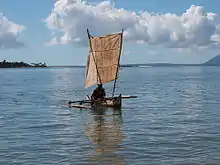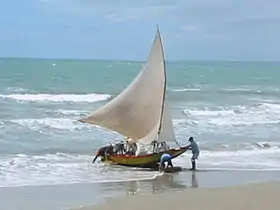
Lakana, also known as la'kana or laka, are traditional outrigger canoes of the Malagasy people of Madagascar. It is a single-outrigger canoe with a dugout main hull.
It is traditionally a sailing vessel, but most lakana are now equipped with motor engines. The sailing rig could be one of two types. An Austronesian square-sail is more common (e.g. in Ambaro Bay).[lower-alpha 1] This rig is limited to largely downwind use, has limited ability to sail with the wind on the beam and no windward capability. In ordinary use, they are sailed out to the fishing grounds on the land breeze that occurs in the morning and then return on the sea breeze that starts later in the day. The lateen rig is used for larger lakana, with examples found in, for instance, Narindra Bay. The lateen rig allows a lakana to sail closer to the wind, so giving some windward performance.[1]
The boat is often referred to by the general French term "pirogue", which can include boats with no outriggers.[2] The technology was adapted in neighboring East Africa, like the Tanzanian ngalawa and the Fulani laana.[3][4]
These are made from Farafatsy wood (Givotia madagascariensis (Euphorbiaceae)). Its outrigger is of Mafaiboha wood (Commiphora mafaidoha (Burseraceae)) though locals prefer the Hazomalany wood (Hazomalania voyronii of the family of Hernandiaceae).[5]
See also
Nptes
- ↑ A square sail, in this sense , is generally defined as a sail that, when it is at rest, is at right angles to the direction of the keel of the boat or ship on which it is set. This means that a square sail has a front and a back surface and a left and a right vertical edge. That applies in the case of this Austronesian sail, though it differs from other examples of square rig that are suspended beneath a yard which is symmetrically mounted on the mast. The other main class of sail is fore and aft rig, where the sail has a left and right surface and a front and a back edge.
References
- ↑ de Rodellec du Porzic, Antoine; Caverivière, Alain (18 July 2017). "Principaux engins de la pêche traditionnelle et leur sélectivité sur la côte nord-ouest de Madagascar (baie d'Ambaro)". Les crevettes côtières de Madagascar : Biologie, exploitation, gestion. IRD Éditions. pp. 121–142. ISBN 978-2-7099-2291-3. Retrieved 11 January 2023.
- ↑ James Richardson (1885). A New Malagasy-English Dictionary. London Missionary Society.
- ↑ Claude Allibert (2011). "Austronesian migration and the establishment of the Malagasy civilization: contrasted readings in linguistics, archaeology, genetics and cultural anthropology". In Tim Curtis (ed.). Islands as Crossroads: Sustaining Cultural Diversity in Small Island Developing States. UNESCO. p. 45. ISBN 9789231041815.
- ↑ A. M. Jones (1964). Africa and Indonesia the Evidence of the Xylophone and Other Musical and Cultural Factores. Brill Archive.
- ↑ TRANS-MAD Developement Parc National de Kirindy-Mite





